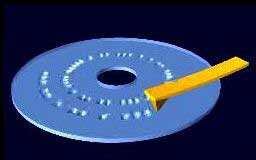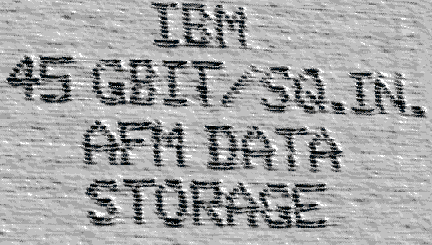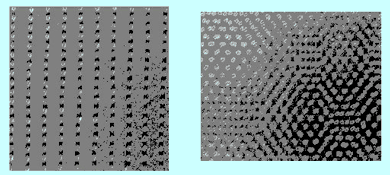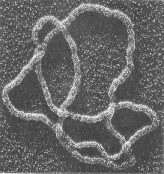- HOME
- VISIT
- ABOUT
- TOURS
- VISITOR FAQs
- LOCAL RESOURCES
- FAST FACTS
- MOAH HISTORY
- WILLIAMS HOUSE
- VICTORY GARDEN
- BOARD AND STAFF
- EXHIBITS
- CURRENT EXHIBIT
- PERMANENT EXHIBITS
- FUTURE EXHIBITS
- PAST EXHIBITS
- ARCHIVED EXHIBITS
- COLLECTION
- COLLECTION HISTORY
- DONATE TO THE COLLECTION
- SEARCH COLLECTION
- PROGRAMS & EVENTS
- CALENDAR
- ADULT PROGRAMS
- CHILDREN'S PROGRAMS
- ANNUAL EVENTS
- PAST EVENTS
- SPECIAL EVENTS
- GET INVOLVED
- MEMBERSHIP
- VOLUNTEER
- GIFT OPPORTUNITIES
- STAY CONNECTED
- EMAIL SIGNUP
- NEWSLETTERS
- PRESS
- Membership Response
The Future
Advanced magnetic recording mediaAs bit density on recorded media increases, the adjoining bits (magnetic domains) can interfere with each other, causing changes in the recorded data pattern. The effect can be avoided by imposing a three dimensional pattern on the surface that leaves each magnetic cell magnetically isolated from its neighbors.
Building media with multiple layers of material having different magnetic characteristics also helps to isolate the magnetic domains and increase achievable density.
Using magnetic materials requiring more energy to magnetize also helps stability and improves density, but may cause difficulties for recording head designers. By heating only the spot to be recorded with a very small laser generated beam, the recording energy needed is reduced, and the stored pattern remains stable at lower temperatures.
Advanced magnetic recording media will carry the brunt of the recording load for the next few years - and perhaps longer, as disk drive designers have proven able to extend drive capabilities far beyond past predictions.
Magnetic Random Access Memory
Within a few years, it should be possible to manufacture fast memory chips for main computer memory that will retain their data when power is removed. These chips use magnetic materials as part of their design, and might be considered the lineal descendants of core memory and semiconductor based dynamic RAM.
Atomic Force Microscopy (AFM) and Thermomechanical Storage
 IBM's Almaden Research Center pioneered the use of AFM for reading and writing data
in 1990. Data was written by a thermomechanical process, applying local heating and
force to a polycarbonate surface through a microscopic scale tip.
IBM's Almaden Research Center pioneered the use of AFM for reading and writing data
in 1990. Data was written by a thermomechanical process, applying local heating and
force to a polycarbonate surface through a microscopic scale tip. Recording densities of up to 45Gb/in² were achieved. The decidedly non-digital
image shown was made as a demonstration of capability. 12 years later, magnetic
recording densities in mass produced disk drives are approaching this level.
Recording densities of up to 45Gb/in² were achieved. The decidedly non-digital
image shown was made as a demonstration of capability. 12 years later, magnetic
recording densities in mass produced disk drives are approaching this level.
 Further research at IBM's Zurich laboratory extended the capabilities of AFM
recording, and densities of 400 Gigabits per square inch have been demonstrated in
the laboratory - about 20 times the recording density of advanced magnetic disk drives.
It remains to be seen if magnetic recording can demonstrate such high areal density
in manufacturable products.
Further research at IBM's Zurich laboratory extended the capabilities of AFM
recording, and densities of 400 Gigabits per square inch have been demonstrated in
the laboratory - about 20 times the recording density of advanced magnetic disk drives.
It remains to be seen if magnetic recording can demonstrate such high areal density
in manufacturable products.
So far, AFM appears to be a write-once process with data transfer rates much slower than those of magnetic recording.
Photos courtesy of IBM
DNA Storage
 There are two main advantages to DNA computing--the high density of data storage it
offers and the efficiency of simultaneous processing.
There are two main advantages to DNA computing--the high density of data storage it
offers and the efficiency of simultaneous processing.
An August 1998 Scientific American article entitled "Computing with DNA," notes that "one gram of DNA, which when dry would occupy a volume of approximately one cubic centimeter, can store as much information as approximately one trillion CDs."
But what has researchers most excited about the potential of DNA computing is the prospect of being able to process huge amounts of data simultaneously. Traditional silicon-based computers, however powerful, still solve complex computations sequentially. Each possible solution or answer must be checked before it is rejected as incorrect or accepted as correct. Even with multiple parallel processors certain kinds of mathematical problems such as "key" systems used to generate encryption codes can take years or even hundreds of years to solve.
With DNA computing, each solution or answer is tested simultaneously. A highly automated DNA computer might be able to "crack" a message encrypted using one of the standard 72 quadrillion "keys" or set of instructions in as little as two hours.
In addition to national defense applications, encryption codes are used to protect all kinds of sensitive data including data transmission between banks and the Federal Reserve and sensitive telephone conversations on classified topics. Still other potential applications of DNA computing include the efficient decoding of human DNA and advances in genetic-based disease detection, prevention and treatment as well as further advances in DNA "fingerprinting" for law enforcement purposes.
The field of DNA computing is still in its infancy and no one really knows exactly where it will lead in practical terms.
Holographic storage
Holographic image storage has been practical for some years, with the anti-fraud holograms on credit cards and software boxes among examples of current uses. Lasers are used to record patterns of spots representing digital data, with the spot patterns distributed throughout the storage medium for each image. Because of this distributive technique, it is actually possible to reconstruct data (or an image) if only a portion of the recording medium is available, albeit with degraded quality. Current development includes holographic data storage on disk media, but the ultimate goal is to obtain a reliable, inexpensive storage device using a three dimensional block of material in order to obtain very high storage density.
Quantum-level storage
Scientists are investigating the possibility of storing information in the quantum spin state of atoms. Still in the early stages of research, quantum level storage could result in extremely high storage in extremely small volumes.
What is HAL's Memory?
HAL 9000, the intelligent computer in 2001 - A Space Odyssey, does not have its technology revealed in the movie, so we are left to speculate. The clear blocks removed by Dave (the astronaut) as HAL is being disabled might well be some form of holographic memory. Holographic memories currently under development do use transparent crystals incorporating data written in three dimensions as minute spots by laser. Current technology doesn't permit construction of a memory suitable for a HAL class computer, but if the current rate of technological improvement is maintained, it might well be possible within the next few decades.
As HAL might say -- "Here's looking at you, Dave"

|
This page
last updated: May 6, 2010 Original content: Copyright © 2000, 2001, 2002-2010 Museum of American Heritage Trademarks are the property of their owners |
 |
Join today! Membership dues help sustain MOAH. For more information and to download a Membership Form
LEARN MORE HERE
For questions and comments
Contact Us.
Mailing Address
PO Box 1731, Palo Alto, CA 94302
351 Homer Avenue
Palo Alto, California
p. 650.321.1004
e.



